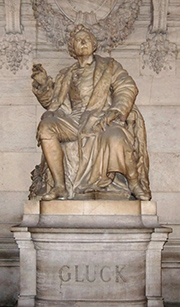Mozart’s “La clemenza di Tito” is very well-known. But Gluck’s setting of the same libretto by Pietro Metastasio with “music of a completely different style, never heard before” offers a good alternative.
Ten years before Christoph Willibald Gluck premiered his famous first reform opera “Orfeo ed Euridice” in 1762 in Vienna, he travelled throughout Europe without a permanent position (to London, Hamburg, Copenhagen, Dresden, Vienna, Prague), accepted commissions for compositions and presumably also joined travelling opera troupes from time to time to earn his living. In summer 1752 he arrived in Naples in order to compose an opera for the name day of Charles VII (later Charles III, King of Spain), a work commissioned by the theatre impresario Diego Tufarelli.
“La clemenza di Tito” is set in Rome in the year 79 AD and deals with the good nature and clemency of the Emperor Titus. Vitellia, the daughter of the deposed Emperor Vitellius, covets the throne. As Tito favours the foreign Princess Berenice to her, she convinces her lover Sesto, a close confidant of Tito, to take part in an uprising against him and to murder him. When, however, Tito decides to take a Roman consort and sends Berenice away, she wants to change her plan. But once again, the Emperor decides in favour of another woman, Servilia, and the information that she remains loyal to Annio and that Tito no longer wants her for his wife reaches Vitellia too late – the uprising can no longer be stopped.
Full of shame, Sesto tries to flee after the supposed murder of the Emperor, but is stopped by Annio and persuaded to face the unharmed Tito. However, the Emperor initially regards Annio as the traitor, as he has taken the conspirator’s emblem from Sesto. Sesto’s role becomes evident when Lentolo, the co-conspirator disgused as Tito, whom Sesto had mistakenly stabbed, identifies him as an accomplice. In the belief that Sesto will be executed because of her actions, Vitellia finally decides to confess to her involvement. As a result, the good-hearted Emperor pardons all involved, and Vitellia marries Sesto, and Servilia Annio.
The first performance on 4 November 1752 in Naples was to have lasting consequences for Gluck. Tufarelli’s expectation of a “a music of a completely different style and never heard before” was fulfilled, especially in the form of the aria “Se mai senti spirarti sul volto”. When Sesto is to be led before the Senate for questioning at the end of the second act, he leaves his lover Vitellia with the words: “If you ever feel a faint breath on your face, slowly moving, say: these are the last sighs of my faithful one who dies for me.” Gluck set this text to music in a manner which caused his contemporaries in Naples amazement and even led to criticism for composing in a way that was against the rules. Francesco Durante (1684–1755), the famous and well-regarded composer and teacher of Pergolesi and Piccini was to settle the dispute. After thoroughly studying the score, he apparently said: “I would not like to decide whether this passage is entirely in accordance with the rules of composition; I can only tell you this, that all of us, starting with me, would boast very highly of having thought of and written such a passage.”
This reputation preceded him, and when he reached Vienna at the end of 1752, Prince Joseph Friedrich of Saxe-Hildburghausen had already asked the imperial Kammersängerin Theresia Heinisch to sing the aria for him; as a result, he was to become Gluck’s patron. This enabled him not only to present their Imperial Majesties with “Le Cinesi” in 1754 and “La danza” in 1755, but he was also granted the title “Kapellmeister of the Prince of Saxe-Hildburghausen” and was able to secure his position in Vienna. Under theatre director Giacomo Durazzo he was finally appointed “Direttore generale della Musica” in 1763, and thereby finally established himself as an opera and ballet composer.
Gluck’s “La clemenza di Tito” remained unperformed for over 200 years, even though the libretto was always known through Mozart’s eponymous opera. It was only revived in 1987 in Metz under Jean-Claude Malgoire. Cecilia Bartoli thrilled audiences with this music in 2001 when she recorded a CD with Gluck arias, including several from “La clemenza di Tito.”
Benjamin Hühne
(from [t]akte 1/2024 – tranlation: Elizabeth Robinson)



